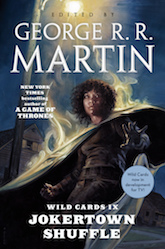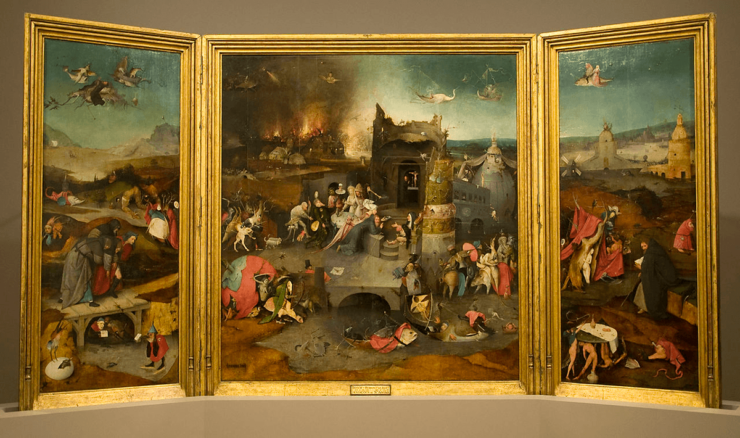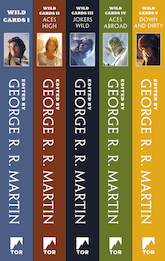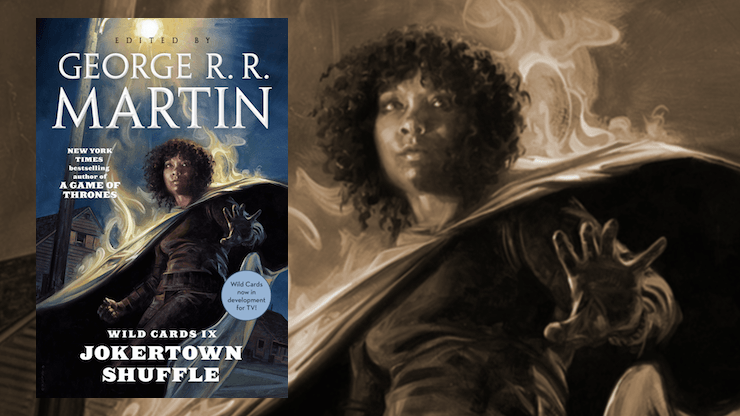Hello again, and welcome back to the Wild Cards reread! Here we are with 1991’s Jokertown Shuffle (Book IX), the second installment of the jumper trilogy (falling between One-Eyed Jacks and Dealer’s Choice). In April of 2019, Tor will be republishing the book along with two new stories by Carrie Vaughn and Cherie Priest. This is my first time reading this one—it’s a bit infamous amongst Wild Card readers, though, so I’ve heard quite a bit about it in advance. Here we go!
Overview
This volume’s set in 1990; a group of jokers and jumpers maintain an uneasy truce on Ellis Island (aka “the Rox”), which is protected by an invisible wall. The jokers see the space as a safe haven in a city that treats them as subhuman. For the teenage jumpers, the Rox is their fortified retreat—a place to hide out when they get tired of causing trouble in the town. The jumpers’ power, spread by Prime (Loophole Latham), enables them to initiate a wave of terror by jumping into people and destroying or humiliating them: think Lord of the Flies meets super-powered ultraviolence. In an ill-advised effort to solidify their power, the jumpers and jokers begin blackmailing nats by jumping them into joker bodies. As a result, a trail of money and luxury goods moves toward the Rox and the city government finds itself paralyzed by the jumper scourge.
The relationship between nats and wild cards had been going downhill before this latest debacle, of course, but the panic the jumpers cause exacerbates an already volatile social and political situation into a full-blown crisis. It all comes to a head when Bloat, the Rox’s teenaged joker leader, declares Ellis Island a separate joker territory and its own state. He manages to repel the inevitable military invasion at the end of the book, with the inevitable final showdown left for the third volume of the trilogy, Dealer’s Choice.
Seven authors contributed to the original volume, featuring the main characters Bloat, Tachyon, Brennan, Cap’n Trips, Black Shadow, Veronica, and Jerry; the newly added POVs in the 2019 edition are Lady Black and Ramshead. Usually the first and second Wild Card volumes consist of separate chapters broken up by interstitial vignettes. In the previous book, the interstitial was actually a character chapter (Jerry’s story) split up for the in-between bits. In this volume, three separate chapters are broken up throughout; this means that structurally, it comes pretty close to reading like one of the series’ mosaic novels.
So that’s the rundown—let’s see what happens in each character’s story…
Buy the Book


Jokertown Shuffle
Brennan’s story
This chapter brings to a conclusion the feud between Brennan and Kien Phuc, who both get a POV. Jennifer is injured during an attack on the house she and Brennan share in the country, where they live with the homunculi. Her mind gets ejected from her body into a psychologically-shaped alternate dimension, which Brennan is able to access with the help of Trace. Kien gets sucked into Jennifer’s alternate dimension, where he and Brennan are both plagued by the spirits of their dead and the events of their past. The men have a final confrontation before Jennifer and Brennan escape, leaving Kien trapped in the psychological hell dimension: at long last, Brennan has overcome his old enemy.
Alternate worlds created by the mind reoccur throughout this book; not only are they real and dangerous, but people and things are able to travel back and forth between these realities and the world in which the story is taking place. This sort of mind-space-time continuum also plays a major role in Bloat and Black Shadow’s arcs.
Mark Meadows’ story
The plot of Mark’s chapter is shaped by the war on drugs, ramped up steadily throughout in the late 1980s. The era that gave us the “This is Your Brain on Drugs” campaign poses a bit of a problem for Cap’n Trips, now a rogue ace and druggie (according to the government). On the run and without his chemical cocktails, Mark’s simply a middle-aged nat. With no other options, he seeks shelter on Ellis Island. He’s desperate to help his daughter Sprout, who’s been stuck in a juvenile detention center. (Which…is it legal to just randomly declare a kid a ward of the state and stick them in Juvie?).
Naïve and hapless as always, Mark has no idea that Blaise has it out for him; the evil (and apparently extremely paranoid) Blaise sets up a death trap for Meadows at Sprout’s detention center. Mark nevertheless is able to spring his daughter free with help from Durg, an unexpected George Bush avatar, and the Turtle. Rather disturbingly, Mark also has a sexual relationship with a teenaged jumper girl, K.C. Strange, who also aids in freeing Sprout. K.C. conveniently jumps away when her body dies during Blaise’s attack and then disappears from the story. The ace and his daughter disappear thereafter. For now.
Black Shadow’s story
Black Shadow (aka Shad) is an ace who feeds off the heat and photons emanating from the people and things around him. He is able to manipulate light so that he can inhabit a cloud of impenetrable darkness—pretty cool power. In an effort to help his friend Shelley (one of the rich nats blackmailed after being jumped into a joker body), Shad begins investigating the jumpers. With the help of Croyd, Shad discovers a warehouse serving as a jumper hideout in the city that’s filled with stolen goods, caged nats trapped in joker bodies, and tons of documentation about their various criminal activities. His jailbreak frees Cody and brings in the cops to the rescue. After being incorrectly targeted by the cops, he is saved by the rather interesting Chalktalk, who can create other worlds with her chalk art. One of the most fascinating segments in the entire book, to my mind, is Chalktalk’s alternate NYC. Chalktalk eventually gets Black Shadow to the Rox, where he will save Tachyon.
Black Shadow’s a vigilante who fights criminals in the streets, and during the day he takes on a variety of disguises—identities that he describes as his “masks.” He’s Mr. Gravemold, and Wall Walker, and a slew of others. It’s gotten to the point that he doesn’t really know who he is anymore, and can barely figure out what he – Neil Langford– thinks or wants. Shad’s story deals with the recurrent theme of identity and selfhood that are so prevalent throughout the Wild Card series (and were particularly prominent in the last book, One-Eyed Jacks). Ultimately he rediscovers his sense of self, remembering who he really is, stating in the repeating refrain, “I’m Black Shadow. I’m Black Shadow.” Darkness, he realizes, is his “welcoming mask,” the one that hides and protects him.
Veronica’s story
In this quiet tale, former prostitute Veronica gradually comes to terms with what happened to her in the last book, including the death of Hannah Jorde, her lover and former therapist. Veronica struggles with her grief, her drug addiction, her body image, and her slow feminist awakening. She may have turned her wild card, but numb as she is, she doesn’t attempt to develop or train her power. In fact, although she’s been hiding out with the radical feminist group WORSE, she dislikes their cruel practices. When she realizes that Hannah was killed by a jumper, and that the Latham, Strauss law firm were involved, however, Veronica steps back into the fray. Yes! Go get ‘em, girl! Her attempt to confront Latham fails thanks to his henchwoman Zelda, though, leading Veronica to realize that her wild card only works against men: “It made sense, in that twisted way the wild card sometimes had. The only power she’d ever had was over men.” She’ll go on to help the more successful (male-led) hit on Latham.
Veronica’s experience is just really depressing, especially for everyone who’s ever wanted to smash the patriarchy. She had a lot of potential and seemed to offer the possibility of a powerful-but-flawed female ace POV, one who could have really flexed her muscles over subsequent books. I’m bummed that when we finally find an actual card-carrying feminist in the Wild Cards world, she’s so run down by life that at the end of her story that she ends up leaving New York, and the playing field, altogether. Our only female POV in the (original) book fizzles out.
Jerry’s story
Ever since his brother’s death, Jerry has been carefully spying on Latham, occasionally bringing in Popinjay for help. His various attempts to assassinate Latham have failed, and Jerry realizes that he’ll only be able to kill him with the help of another ace. Accordingly, he and Beth (his widowed sister-in-law) rescue Veronica, who’s been hospitalized in a coma. Once she wakes up, they go after Latham together. Veronica can’t bring herself to kill Latham with her dude-killing-power, but Jerry manages by stabbing Latham’s brain with his bone finger. This leads to a bone infection and sickness, which…really can’t be a good thing. Latham’s dead, though, which means that there won’t be any new jumpers—but the current ones can still do their thing. (I’d been hoping that with Latham dead, their power would be dispelled entirely.)
Bloat’s story
Bloat is a self-loathing mind reader whose enormous body is trapped on Joker Ellis Island. His powers allow him to create a magical boundary that keeps most people away from the Rox , fulfilling his primary goal of protecting the Joker community. He’s a very young and very inexperienced leader, which means that he’s constantly embroiled in a nasty power struggle with the jumpers.
There’s also some serious weirdness here involving Tachyon. Bloat had had a crush on 16-year-old Kelly Ann Jenkins, but Tachyon gets jumped into her body, and Bloat confuses him with Kelly, constructing an elaborate, Beauty and the Beast-style fantasy romance around a completely powerless and brutalized victim. So…not great. In the midst of all this, we come to realize that Bloat can control dreams, and suddenly the people and things from those dreams make their way into reality. As in Brennan’s story, the ghosts of everyone’s pasts begin appearing in the present, in the very world of the Rox. As Bloat’s power grows, he begins to manifest his dreams (and basically whatever else he wants) in the real world. After the military attack on Ellis Island fails, Bloat turns the place into a fortified glass palace with delicate bridges spanning the bay.
Dr. Tachyon’s story
Tachyon is captured by Blaise and switched into the body of a 16-year-old nat girl, Kelly. Helpless now, with no mentat mind powers in the new body, he is imprisoned on the Rox, starved, brutalized, and raped by Blaise repeatedly. Tachyon-as-Kelly gets impregnated by his deranged grandson. He names the fetus Illyana and becomes a nurturing pregnant woman, with nightly romantic dreams spent swooning in the arms of the heroic and anonymous Outcast (Bloat—see above).
It goes on for some time like this—Bloat is not able to orchestrate a successful escape for his “princess” until Black Shadow shows up. Shad is able to get Tach/Kelly to freedom. After making it to the Turtle’s junkyard, Tach and the Turtle attempt to get his original alien body back from the Rox right in the midst of the military invasion. Alas, Blaise had already taken Tachyon’s body (and Kelly’s mind inside of it) to his grandpa’s space ship, flying off back to Takis.
The Two New Chapters
The tone of these two stories differ slightly from the rest of the book because they are investigation tales, containing genre elements drawn from crime and detective stories. The two characters help each other out and mostly confine themselves to the area around Jokertown.
Joann Jefferson’s story
Lady Black is a SCARE (Justice Department) ace looking into Mark Meadows’ escape. As befits the genre, this chapter involves a boots on the ground investigation, interviews, and jurisdictional and interoffice politics. Joann, looking into the K.C. Strange angle, is drawn once more to the Ellis Island situation, and especially the teenage runaway aspect. She uncovers some of Bloat’s background, learning that he was dumped by his parents at the Jokertown clinic after his card turned. After confronting Bloat’s parents, she realizes how lucky she was to have her own father, who supported and cared for her despite her dangerous power.
Leo Storgman’s story
I’ve always liked Ramshead, the joker cop from what I think of as the “Wild Cards: The Next Generation” series. In those later books, we see Leo at the end of his career in Jokertown, but in this tale he’s at the very beginning. Leo’s just started as a detective at Fort Freak, tasked with investigating the crime scene Brennan left at the Jokertown Clinic. The story features slacker partners, crooked cops, and a jumper-compromised precinct. The main plot involves the investigation into Cody’s missing son and the aftermath of the warehouse rescue, and ends by driving home the devastation that jumpers can cause with a cop’s body.
The Challenging Aspects…
As I mentioned earlier, this particular Wild Cards book has something of a reputation, given that fan responses were decidedly mixed in the wake of its initial release. For first-time readers, it will probably be the most difficult volume so far, and such was the case for me. Although the sexual violence is not necessarily more prevalent than it is in the other books in the series, this one takes it to a new level with the interfamilial element. Moreover, feminist readers will find several aspects of the plot and characterizations questionable, and there are some serious problems regarding the treatment of transgender-related themes and concepts. There are also several unacceptable sexual relationships between adult men and underage girls—not just any adult men, but the good guys, the heroes. Shad, for example, after having sex with Chalktalk several times, thinks to himself that she might be around twelve. So. The problems in this volume are significant.
Art and Fantasy

This volume uses visual culture in some interesting ways. As a naturally empathetic boy who loved beautiful things, Bloat had taken to art from an early age. Now, Bloat lives in a terribly ugly world, his body disgusts those around him, and he hates himself. Unable to work at his sketchpad anymore, in his dreams the boy constructs a fantasy world of castles, heroes, and beautiful landscapes. His wild card begins to transmute the real world into that fantasy space, with jewel-laden caverns on the Rox and imaginary characters made flesh. The jumpers’ criminal scheme ensures that he can surround himself with art by the great masters, stolen from museums around the world. One work seems particularly compelling to Bloat, and reappears throughout the book: Hieronymus Bosch’s The Triptych of the Temptation of St. Anthony. The early 16th-century piece features monstrous, absurd, and surreal creatures, and in them Bloat recognizes his own kind: “Jokers. They cavorted everywhere you looked.” The point at which Bloat manifests the Boschian monsters and sends them careening after the invasion force is one of the most visually striking moments of the entire book.
Bloat also thinks that “the triptych is a celebration of jokerhood” and sees the Rox as a place that jokers can call their own, an Ellis Island for joker immigrants. “This is the joker homeland,” Bloat declares. Here we find his developing dream of Joker nationalism, a fantasy that Bloat tries to bring to life along with the dreams he actualizes with his powers. The triptych represents his greatest desire. The chapter title “The Temptation of Hieronymus Bloat” emphasizes that Bloat is Bosch; he is an artist whose wild card helps him create a joker world.
Where Bloat finds fantasy and beauty in what some historians have dubbed “high art,’ Chalktalk embodies the other end of the spectrum: street art. She is a prolific street artist, although she works in chalk rather than paints. Her work is ephemeral and quick. Black Shadow finds her scribbling dramatic and strange scenes around every corner, and witnesses her traveling into one of these pictures. Similar to Bloat, who manifests images from his dreams and imaginings, Chalktalk creates whole alternate worlds via her visual medium. At one point, Shad finds himself inside a picture, within a densely built world. It’s actually a tiny alt-history New York City—a fantasy version without the wild card, a fully realized socialist United States in which African Americans are a protected minority and jazz never moved past the big band era (in order to prevent white people from culturally appropriating Black music). For both Bloat and Chalktalk, visuality is the crux for transforming fantasy into reality.
Buy the Book


A Wild Cards Collection: Books I-V
Some General Thoughts
• Power is a major topic in this book: Blaise constantly dwells on the subject of power and covets it. Bloat realizes that he must strengthen his power if he is to shelter the jokers under his protection. Tachyon and Mark Meadows both lose their superhuman abilities and thus become utterly powerless, victimized, and helpless. In fact, the entire jumping phenomenon that fuels this trilogy is about stealing power because the wild card is physiologically tied to a person’s body—when you are jumped out, you lose your wild card ability and the jumper gains it. Meanwhile, nats are completely defenseless against the capricious jumpers, and desperate because of it.
• Get out: Seriously. Everyone knows about the jumpers. Why is there anyone left in NYC, at this point? It seems like there should have been a mass exodus. And why in the world does Tachyon think, as soon as he’s free, “Oh, I’d best skip off to the clinic” where he is liable to be jumped again? Gah! *grabs everyone by the shoulders and shakes*
• The Jumper weakness: We also learn that jumpers can’t jump if they can’t see, but I’m a little unclear on whether this means that they specifically have to see their potential victim, or they just have to be able to see, period. Because if they have to be able to see their victim, they probably shouldn’t be able to jump into random helicopter pilots?
• Croydwatch: This go-round he’s a hairless flying bat creature, and then an armadillo thing.
Thanks for hanging out for this Wild Cards reread! What were your thoughts on Jokertown Shuffle, and the various themes and character arcs?
Katie Rask is an assistant professor of archaeology and classics at Duquesne University. She’s excavated in Greece and Italy for over 15 years.










